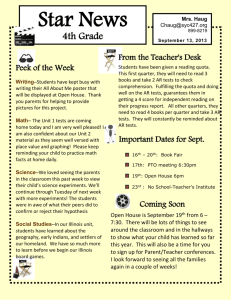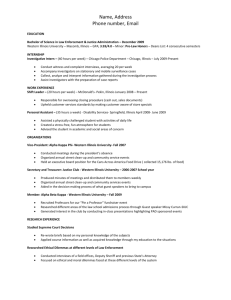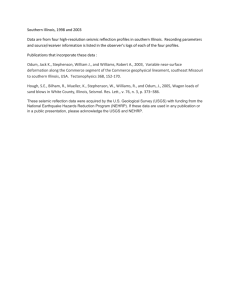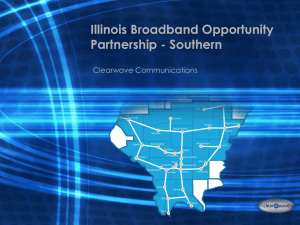Recommendations - illinoisbroadbanddeployment
advertisement
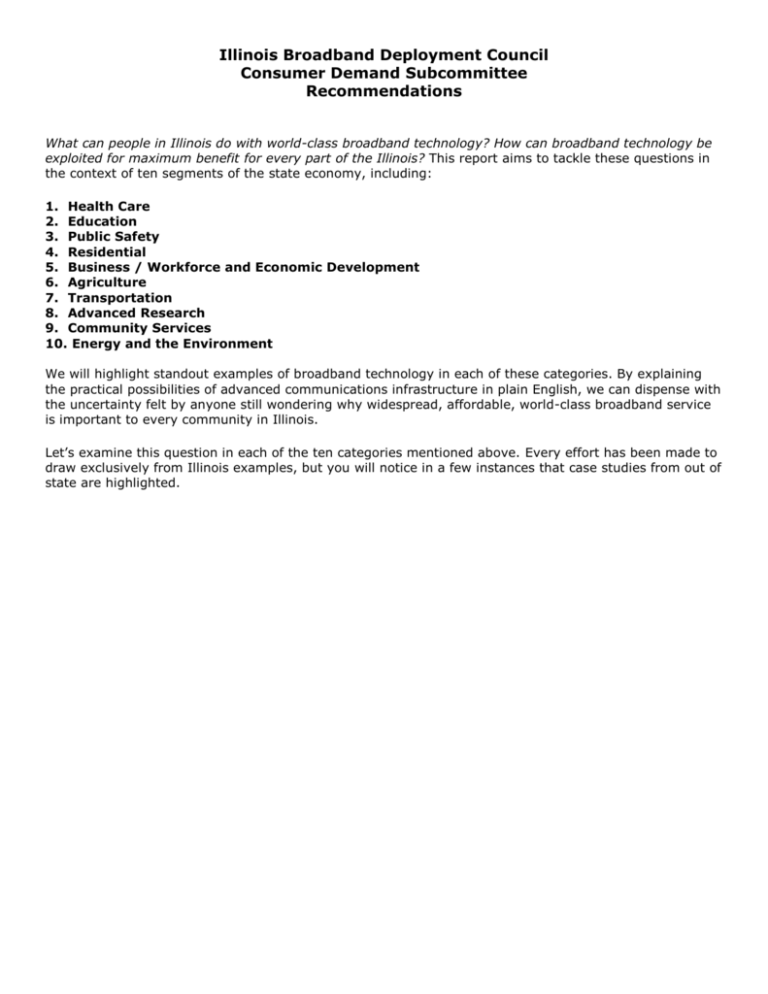
Illinois Broadband Deployment Council Consumer Demand Subcommittee Recommendations What can people in Illinois do with world-class broadband technology? How can broadband technology be exploited for maximum benefit for every part of the Illinois? This report aims to tackle these questions in the context of ten segments of the state economy, including: 1. Health Care 2. Education 3. Public Safety 4. Residential 5. Business / Workforce and Economic Development 6. Agriculture 7. Transportation 8. Advanced Research 9. Community Services 10. Energy and the Environment We will highlight standout examples of broadband technology in each of these categories. By explaining the practical possibilities of advanced communications infrastructure in plain English, we can dispense with the uncertainty felt by anyone still wondering why widespread, affordable, world-class broadband service is important to every community in Illinois. Let’s examine this question in each of the ten categories mentioned above. Every effort has been made to draw exclusively from Illinois examples, but you will notice in a few instances that case studies from out of state are highlighted. HEALTH CARE 4 STANDOUT EXAMPLES --------------------------------------------------Telepsychiatry is a rapidly growing tool used by specialized psychiatrists to connect to people living in remote areas. Psychiatrists can interview patients by video conferencing, a technique involving use of fiber optics in the transmission of quality audio and video at rapid speed to both the patient and specialist simultaneously (http://archive.psych.org/edu/other_res/lib_archives/archives/199821.pdf). Mercer County Hospital in Aledo works with the Robert Young Center for Community Mental Health in the Illinois Quad-Cities to provide telepsychiatry at the Aledo hospital’s Medical Associates Clinic. Since 2006, the Robert Young Center has allowed rural patients and those who cannot travel access to a full menu of psychiatric services. Clients accessing the services connect between a private office in Aledo, Ill., and a psychiatrist located at the Robert Young Center in Moline. Under the arrangement board-certified psychiatrists provide assessments and medication evaluations directly for clients as well as consultative services to referring physicians or agencies. Referrals for the service may be made by physicians, nursing homes, schools, human service agencies, law enforcement or self referrals. Required data transfer rate: 128 kbps is required for both the audio and video of a medical session to be useful to a telepsychiatrist. 384 kbps are recommended for precision video that would allow the specialist to recognize symptoms of medical conditions by the patient’s movements, such as mild tremors and reflexes. Contacts: Tim Putnam, Mercer County Hospital CEO Dr. David Deopere, Robert Young Center President To schedule an appointment, call the center at (800) 322-1431. --------------------------------------------------Trinity Regional Health Systems (Quad Cities) is offering a service that provides personal Web pages for patients to help family and friends communicate. (www.carepages.com/trinityqc). "Carepages" include a message board and photo gallery. Benefits: Provides free, easy-to-use web pages that help patients communicate with loved ones. Family and friends can provide support and encouragement, and recieve updates when someone is providing care. New patient updates are automatically sent via e-mail so that family members don't have to make repeated phone calls as a patient's condition changes. Contact: 888.852.5521. Representatives available Monday - Friday, 8am - 6pm CST Mailing Address: CarePages, Inc. 4043 N. Ravenswood Ave Suite 301 Chicago, IL 60613 866-981-4900 --------------------------------------------------Many rural regions have suffered from shortages in pharmacists. In North Dakota, many pharmacies closed due to the lack of professional pharmacists in rural regions (http://telepharmacy.ndsu.nodak.edu/). Modern technological advancement has led to a new, innovative concept of a telepharmacy. Telepharmacies make use of audio-visual equipment to link pharmacists at a central location to registered pharmacy technicians in remote, rural areas. The pharmacist at the central site supervises the pharmacy technician preparing, labeling, and filling prescription medication at the rural pharmacy. Benefits: Rural areas suffering from a shortage of pharmacists may rely on the telepharmacy to prevent further loss of pharmacies in rural regions. Money and time will be saved for rural residents, as long distance travel to pharmacies will be eliminated. Also, rural pharmacies will be supervised by highly-skilled pharmacists, reducing the number of errors in filled prescriptions. Although fully automated pharmacies are in the making, rural pharmacies would likely not have the revenue that automated technology would require. Required data transfer rate: 512kbps -- DSL quality or better. (http://www.hrsa.gov/telehealth/grants/states/nd.htm ) Contact: Ann Rathke – North Dakota Telepharmacy Project Coordinator (701) 231-5863; Ann.Rathke@ndsu.edu --------------------------------------------------Chicago Department of Public Health (CDPH) is implementing Cerner's Radiology Information equipment, RadNet, and Cerner's Picture Archiving and Communication System (PACS). These technologies will be utilized at 5 facilities operated by CDPH. Currently CDPH acquires radiology images via film. Radiology technologists develop them using photo development chemicals and send them via courier to the Radiologist Group to read and interpret the results. These results are sent back to the requesting health center and/or ordering physician. Benefits: Digital radiology will permit same-day results for patients. This is particularly important for Mammography, Tb and immuno-compromised patients. The PACS system will provide radiologists with a complete, easily accessible medical record to review prior reports and images for reference. Same-day result reporting is made possible because the digital images can be transferred to radiologists almost immediately. Referring physicians also have access to digital images, which previously had to be hand delivered (one at a time) to each relevant medical professional. Digital imaging eliminates processing delays and reduces emissions from the chemicals involved in the wet processing of film. It reduces the cost of film materials, transportation, and processing chemicals and storage. Importantly, eliminating film storage facilities expands available square footage for patient care. Contact: Carlo Govia, Chicago Department of Public Health 312-747-9889 EDUCATION 3 STANDOUT EXAMPLES --------------------------------------------------In the 2007-2008 school term, the Illinois Virtual High School is offering 112 web-based classes with over 4,000 enrollment slots representing 144 high schools from around the state. The Spring 2008 term includes 1,888 students. Illinois certified, NCLB “highly qualified” teachers (most of whom work full-time in traditional classrooms) administer IVHS’s online courses. Middle and high school students with access to an Internet-enabled computer can earn credit in classes ranging from remedial credit recovery classes to the most advanced college-level Advanced Placements (AP). Benefits: IVHS is a state-supported resource that helps all Illinois students access equitable educational opportunities that would otherwise be out of reach due to where they live, scheduling constraints, or other socioceconomic barriers. To date, over 2,000 of the 13,000+ enrollments at IVHS have been for AP courses. Students who successfully complete AP courses and pass the corresponding AP exam can receive credit from most colleges and universities nationwide. Required data transfer rate (bandwidth): IVHS courses accommodate students who have access to dial-up (56kbps) or faster. If broadband was available to every student, IVHS courses could be designed to incorporate more interactive, video- and audio-rich content. Contact: Pete Knopf, Illinois Math and Science Academy (Aurora) --------------------------------------------------The Institute for Chemistry Literacy Through Computational Science (ICLCS) is a partnership funded through a $5M grant by the National Science Foundation that includes the University of Illinois at UrbanaChampaign Department of Chemistry, College of Medicine, the National Center for Supercomputing Applications, and K-12 schools around the state. This project provides training to 114 rural high school chemistry teachers using broadband technology. The program, which exists to strengthen rural high school chemistry programs and increase teachers' comfort with advanced math and graphics tools, includes a two-week summer institute and ongoing virtual training in curriculum that focuses on medicinal chemistry (biomedicine), nanotechnology, agricultural chemistry and molecular chemistry. Virtual presentations over the course of the year provide 340 hours of continuous professional development, mentoring, and support. Benefits: This project exposes rural teachers to new models of instruction that can improve student achievement and prepare them for 21st century careers. The Institute builds teacher competence and confidence with new curriculum and methods, and creates a statewide community of colleagues working together to improve Illinois science education. Required data transfer rate (bandwidth): T1 minimum in every participating school. Contact: Diana Dummitt, UIUC College of Medicine (Champaign) --------------------------------------------------Eastern Illinois University in Charleston has anywhere from 10,000 to 13,000 network users at any given moment, including about 5,000 students in the residence halls. The university is connected to the Internet through a local phone company and the Illinois Century Network, which helps provide affordable bandwidth to nonprofit entities such as schools, libraries, museums and governmental agencies. Students can download as much as they want. Benefits: The student TV and radio department streams its audio broadcasts online. Students also have Web portals for online classes and grading, and the university library provides a large depository of digital content. Required bandwidth: Its network is Ethernet-based with a 10-gigabit per second (Gbps) fiber backbone. Every dorm room has a 100-megabit per second (Mbps) LAN connection. --------------------------------------------------OTHER EXAMPLES: Online Professional Development for teachers ( www.star-online.org ) Real-time tutoring ( http://www.skokielibrary.info/s_kids/Live_Homework_Help/index.asp ) PUBLIC SAFETY A STANDOUT EXAMPLE --------------------------------------------------In the wake of Minneapolis, Minnesota’s tragic I-35 bridge collapse, wireless broadband technology helped maintain communication and information flowing during relief efforts. “Immediately following the collapse, USI Wireless (the company that built and maintains the city network) opened up the subscription-based Wi-Fi service so anyone could use it free. The network was used by local and federal officials [as]…an alternate path for city personnel in the emergency command center to electronically exchange information, such as maps of the area, with personnel working in the field. Specifically, it allowed rescue workers on the mobile command center that was floating in the river to communicate with various city, state and federal agencies during the rescue and salvage operation. And it provided a network for the community to City of Minneapolis resources, hospital emergency coordination units, State of Minnesota Department of Transportation traffic routing information, Red Cross Blood Bank collection points, and local and national news outlets. …three Wi-Fi-enabled cameras …were set up along the river banks near the disaster site to provide a live video feed over the network directly to the command center.” From http://www.usatoday.com/tech/products/cnet/2007-08-09-minneapolis-public-wifi_N.htm --------------------------------------------------OTHER EXAMPLES: Storm-ready communities may rely on online weather alerts ( http://www.stormready.noaa.gov/com-maps/il-com.htm ) RESIDENTIAL A STANDOUT EXAMPLE --------------------------------------------------- High-speed Internet service makes fast, natural, real-time telecommunication with the deaf possible. A broadband connection, a TV set and an easily obtained web camera (or Internet videophone) permit signlanguage interpreters to translate conversations between deaf and hearing people in real time. Benefits: This can help Illinois' estimated 100,000+ deaf citizens and all of their non-deaf friends, family and colleagues. Access to basic telecommunication would improve the social, educational and employment prospects for anyone; for the deaf, who face disproportionately high levels of social, educational and employment challenges, it represents a monumental leap forward in these areas. Required data transfer rate (bandwidth): 512 kilobits per second upload and download - minimum. Contact: John Miller, Illinois Deaf & Hard of Hearing Commission john.miller@illinois.gov --------------------------------------------------OTHER EXAMPLES: Telecommuting/working from home ( http://www.govtech.com/pcio/articles/265781?id=&story_pg=2 ) Home-based online businesses ( http://stores.ebay.com/ ) Fiber-to-the-Home/Fiber-to-the-Premises in Salem, Paxton, Maryville, O’Fallon BUSINESS/WORKFORCE DEVELOPMENT 3 STANDOUT EXAMPLES --------------------------------------------------Starting in 2006, the Verizon Foundation provided a grant to the IL Institute for Rural Affairs for a local initiative whereby small business, government agencies, schools and others in Stark County, IL worked with experts from the Institute to establish and maintain websites for each of the businesses. With the Foundation’s support, new websites give a worldwide audience to rural businesses, including John Leezer’s real estate agency ( www.IllinoisFarms4Sale.com ), State Bank of Speer ( www.speerbank.com ), and the Indian Creek Vineyard ( www.indiancreekvineyard.com ). Benefits: Retaining local businesses and preserving a convenient shopping experience for small town consumers. Bringing global demand to Illinois business owners. Contact: Giselle Hamm, Western Illinois University Illinois Institute for Rural Affairs GF-Hamm@wiu.edu --------------------------------------------------A small town grocery store used to use dial-up for point-of-sale transactions, which meant an excruciatingly long wait for customers at a checkout trying to use credit cards. In a place where no other high-speed access was available, the Illinois Rural Electric Cooperative provided Internet to speed transactions to put the customer experience in a small town store on par with that of any city shopping experience. Contact: Sean Middleton, Illinois Rural Electric Cooperative 217.742.3129 sean@e-co-op.com --------------------------------------------------Illinois workNet (www.illinoisworknet.com ) is a portal for connecting employers and job seekers in Illinois. It was launched in June 2005 by the Governor’s Illinois Workforce Investment Board (IWIB). The portal is a cooperative effort between state economic development, workforce development, education agencies, and local workforce investment boards along with their public and private partners including local governments, community colleges and non-profit organizations. It is designed to provide easy access to information and services through a network of public and private partners. As of August 2006, Illinois workNet was available in 37 counties and the City of Chicago. In these areas, public computer labs with trained staff offer access to the portal. Contact: John Barr, Department of Commerce and Economic Opportunity John.W.Barr@illinois.gov --------------------------------------------------Paxton Tru-Value Store currently uses high speed broadband for phone (VOIP), ordering inventory and as soon as is feasible, Scott Allen will be using the credit card processing. The only thing holding him back at this time is his cost of equipment for his use. Paxton as a community through the electrical cooperative offers “triple-play” throughout the town. The cooperative partnership also has wireless service available at an average of 1MgH of capability both up and down in the rural area. Contact: Bruce Cooper, NOW Wireless bwc@noww.us --------------------------------------------------OTHER EXAMPLES: Community college videoconferencing ( http://www.swic.edu/distancelrn/interactivevideo/faq.jsp ) RealBenefits ( http://www.realbenefits.org/wv/index.php?base_id=55 ) AGRICULTURE 3 STANDOUT EXAMPLES --------------------------------------------------Robert Tammen of Tammen Seed Service in Danforth, IL uses broadband service to communicate with the various seed companies that he distributes. One company in particular (Golden Harvest) would only allow him to use their product if he had high speed broadband access. His profitability depends in large part to his ability to access broadband. Contact: Bruce Cooper, NOW Wireless bwc@noww.us --------------------------------------------------A company just outside of Pesotum, IL utilizes high speed wireless access to run surveillance on their property thereby lowering their cost of insurance. The service costs them $9.95 monthly. Contact: Bruce Cooper, NOW Wireless bwc@noww.us --------------------------------------------------A major farm operation in Thomasboro, IL utilizes broadband to communicate to the field operations, surveillance on their anhydrous tanks and out buildings, and to efficiently run their financial applications for their operation. Contact: Bruce Cooper, NOW Wireless bwc@noww.us --------------------------------------------------OTHER EXAMPLES: Ag tourism ( http://www.agfun.com/ ) Rural Utilities Service broadband grants ( http://www.usda.gov/rus/telecom/highlights.htm ) --------------------------------------------------MORE INFO: In August 2007 the US Department of Agriculture reported that Illinois has the eighth highest number of farms in the country with 72,400. Of all Illinois farmers, 55 percent reported using the Internet and of that group 46 percent relied on dial-up service to connect. From http://usda.mannlib.cornell.edu/MannUsda/viewDocumentInfo.do?documentID=1062 “When most people think of networks they think of transferring files between computers or downloading web pages from the Internet. Networks can be used for much more than this. A network can be used on a farm for … remote monitoring, information transfer, remote control, remote diagnosis, asset tracking, and voice communication. As modern farm sizes increase and labor shortages become more acute, farmers have to do more work over greater areas than ever before. Although constant monitoring and control of labor and assets (such as irrigation systems and pumps) is required, the spatially dispersed nature of those assets means that much time is wasted in transit. Significant managerial efficiency gains could be realized if these tasks could be carried out remotely. A decrease in the amount of labor required and an increase in productivity could result in real dollar benefits to farmers.” From http://www.farmnetworks.org/Information/AboutFarmNetworks/tabid/54/Default.aspx TRANSPORTATION 3 STANDOUT EXAMPLES --------------------------------------------------Since the 1990's IDOT has used fiber optics to monitor and control major signalized intersections. Recent application of broadband technology has allowed IDOT to view real-time video of these locations and other high-accident locations along the State Route and Expressway systems. Benefits: Traffic flow though intersections equipped with dynamic/remotely controlled traffic control devices provide for a much smoother movement flow thereby reducing potentials for vehicle-related incidents, congestion and exhaust pollution. Observing high-accident locations in real-time allows for immediate dispatch of emergency response resources and faster site clean-up and restoration of traffic flow. Contact: Mark Kinkade or Louie Midiri, Illinois Department of Transportation Louis.Midiri@illinois.gov --------------------------------------------------IDOT deploys and controls closed circuit security systems (cameras on a protected network) to detect activities that may threaten the State's highway transportation network, including bridges, overpasses, etc. Benefits: Broadband technology allows IDOT, together with various law enforcement organizations, to protect and preserve the safety and continued availability of Illinois highway system for use by all lawabiding motorists. Major interruptions to this critical State infrastructure would severely affect not only daily transportation activities but much of the State’s critical, transportation-dependent economic activity as well. Contact: Mark Kinkade or Louie Midiri, Illinois Department of Transportation Louis.Midiri@illinois.gov --------------------------------------------------OTHER EXAMPLES: Wireless broadband on trains ( http://illinoisbroadbanddeployment.pbwiki.com/f/BroadbandProject.pdf ) ADVANCED RESEARCH A STANDOUT EXAMPLE --------------------------------------------------Illinois is a world leader in many advanced scientific and technology research areas, supported primarily by its universities and national laboratories. Major research projects in Illinois include those related to high energy physics, computational science, genomics, proteomics, systems biology, astrophysics, nanotechnology, materials science, photonics, optics, data mining, networking, computer science, and many others. This research will be the foundation for future industrial and economic development in Illinois. Advanced communication services are essential to maintain this position. Traditionally, advanced scientific and technology research has been based on processes involving close interactions between theoretical development and investigative experimentation. Increasingly, these processes use digital tools for modeling and simulation requiring extremely large volumes of data and distributed computational processes. Because science and technology research is a collaborative activity, high performance digital communications are required among highly distributed sites, state-wide, nationally and internationally. Required communication capabilities not only require bandwidth that is substantially higher than that used by consumers and business, but also specialized capabilities that allow research communities to directly control and configure underlying infrastructure resources, especially high quality fiber-based optical fiber based wavelength channels. Currently, Illinois has world-class advanced communication services and infrastructure that support its scientific and technology research activities. However, capacity for future expansion is urgently required, especially additional direct access to multiple fiber based wavelength channels that can be closely integrated with research infrastructure, including scientific instruments. Contact: Joe Mambretti, Northwestern University International Institute for Advanced Internet Research --------------------------------------------------OTHER EXAMPLES: Argonne National Laboratories (http://www-news.uchicago.edu/releases/96/961017.materials.research.shtml ) COMMUNITY SERVICES 2 STANDOUT EXAMPLES --------------------------------------------------Community Technology Centers (CTCs) are the entryway for training and educating underserved populations. They typically focus on users and offer after school homework and arts activities, workforce readiness, training for seniors and programs for those learning English as a Second Language. Robust broadband is needed to support their activities. Many CTCs function within human service agencies. Benefits: High speed internet in CTCs and in the homes of CTC patrons builds on CTC services as children do homework and parents participate in their children’s education via email contact with teachers. Participation in civil society, a reduction in isolation for seniors and people with disabilities, and the ability to use search tools to expand knowledge for both adults and children. Increasing ‘work from home’ opportunities would be a further benefit as would, for instance, enabling contact between foster parents and the agencies that they work with and facilitating foster children’s contact with siblings. In the future, other human service agencies will use broadband for activities such as senior well-being checks, with one email to a group of clients triggering daily responses or regular contact with 'Meals on Wheels' clients to check on food needs or surpluses, and indications as to whether they've actually eaten and whether they've thrown out any garbage. Another agency will use broadband to enable foster parents to maintain records of immunizations, MD visits, school testing and child progress Required Data Transfer Rate: Single sites with large numbers of users and robust access across underserved communities. 512 kilobits per second upload and download. Access to T1 lines or business DSL, 760k up/1.5 down preferred Contacts: Licia Knight, Director, Community Standards of Excellence, Lumity Deborah Strauss, Consultant on Special Projects, Lumity ddstrauss@gmail.com --------------------------------------------------The Human Service organization, Erie House, has extensive tech-based programs for all ages including after school and English as a Second Language, and has clients who have moved through their programs from ESL to GEDs and then into the workforce. Contacts: Licia Knight, Director, Community Standards of Excellence, Lumity Deborah Strauss, Consultant on Special Projects, Lumity ddstrauss@gmail.com --------------------------------------------------- ENERGY & THE ENVIRONMENT A STANDOUT EXAMPLE --------------------------------------------------Nearly all Illinois consumers can file their state income taxes for free at www.tax.illinois.gov and many can also file federal taxes online at www.irs.gov. A March 20, 2008 Chicago Tribune article reports "In Illinois, more are e-filing taxes.” The number of people filing their taxes electronically is projected to eclipse paper filings for the first time in Illinois this year. Benefits: Not only has electronic tax filing saved the state $2.4 million in paper processing and postage costs since the 2008 tax season began, it reduces the amount of landfill trash, reduces energy use and the pollution associated with manufacturing, transporting, and recycling new paper products. Contact: Katie Ridgway, Illinois Department of Revenue Katherine.Ridgway@illinois.gov To create new broadband success stories in Illinois, and to foster wider awareness of those that exist, we recommend that everyone committed to economic progress in Illinois -- especially the Illinois Broadband Deployment Council, the eventual non-profit state broadband organization enlisted through Public Act 95684 and other relevant organizations -- pursue these four outcomes: 1. EXPANDED INVENTORY OF BROADBAND BENEFITS. Drawing from expertise in our state universities, libraries, hospitals and businesses; using clear metrics to put case studies in plain English, Illinois should publish a searchable, easy-to-find, ever-growing catalog of “killer” broadband applications from across the state. (This report marks a concrete step toward this goal.) 2. EXPANDED INVENTORY OF BROADBAND COSTS. Every case study highlighted in this report depends on some user’s ability to pay for access to high-speed information and communication networks. In Illinois, we know anecdotally that the vast majority of residential consumers have access to “better than dial-up” Internet service. However, even in the residential category of access, there remain great disparities in the cost of fast Internet options. Further, it’s critical we not overlook the much greater bandwidth requirements of the other nine broadband consumer sectors outlined in this report. If we want to encourage broadband-enabled growth, world-class broadband networks must not be cost prohibitive. California’s groundbreaking collection and publication of residential broadband pricing statewide is a model for one segment of the economy that should be repeated for non-residential broadband consumers in Illinois. We suspect that residential offerings in Illinois are comparable to those in California, but we lack comprehensive data on the availability and pricing of services for business, education and other enterprise-level consumers of broadband service. With more information, we can make better decisions about whether and how to stimulate beneficial applications in all of the relevant segments of our economy. 3. TRAIN-THE-TRAINER PROGRAMS. To assist local and regional communities in “visioning” and other development plans, Illinois should cultivate programs like WIU’s MAPPING effort, the Minnesota-based Blandin Foundation’s “Get Broadband” project, and periodic large-scale conferences, symposiums and colloquiums for community leaders to convene regionally or statewide to meet experts and share strategies for exploiting the potential of broadband technology in every sector of the local economy. 4. STATE LEADERSHIP IN DIGITAL GOVERNMENT. State resources to improve communications access and infrastructure should be used not just to map and predict existing demand for services, but to stimulate new demand. Creating more web-based tools (like Illinois workNet and online tax returns) for widereaching government services is the best way to start. Prioritizing the development of new online tools will require cooperation among state agencies and our many research institutions. In closing, we think Illinois would be wise to take direction from California's Broadband Task Force, which stated as a central goal in their landmark 2007 report: "[We] must drive the creation and use of applications that produce the greatest economic, educational, and social benefits for [our] economy and communities." Indeed, let’s use this report and the dialogue it will produce to find more compelling applications that should be added to this beginning and replicated across the state.

